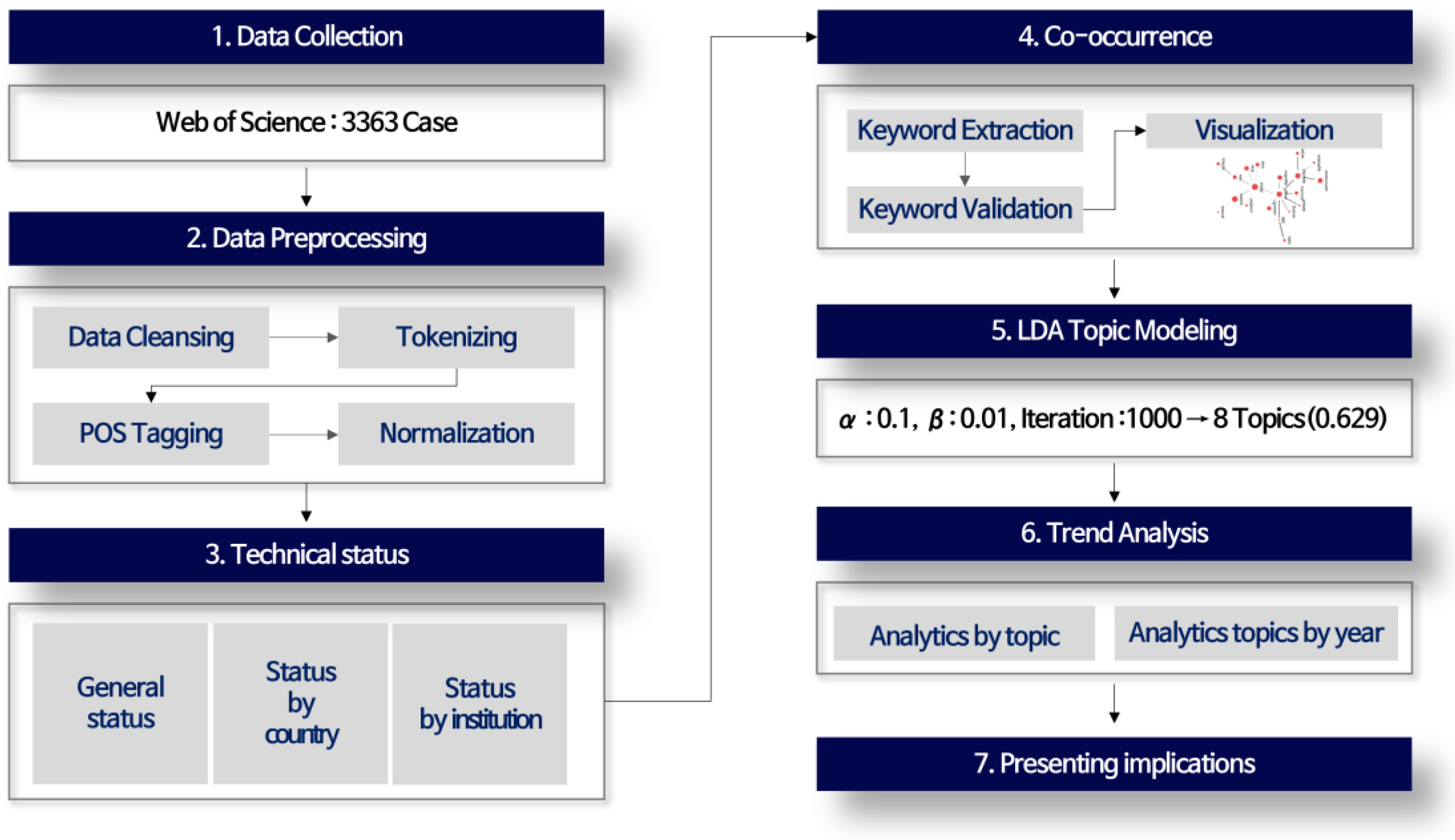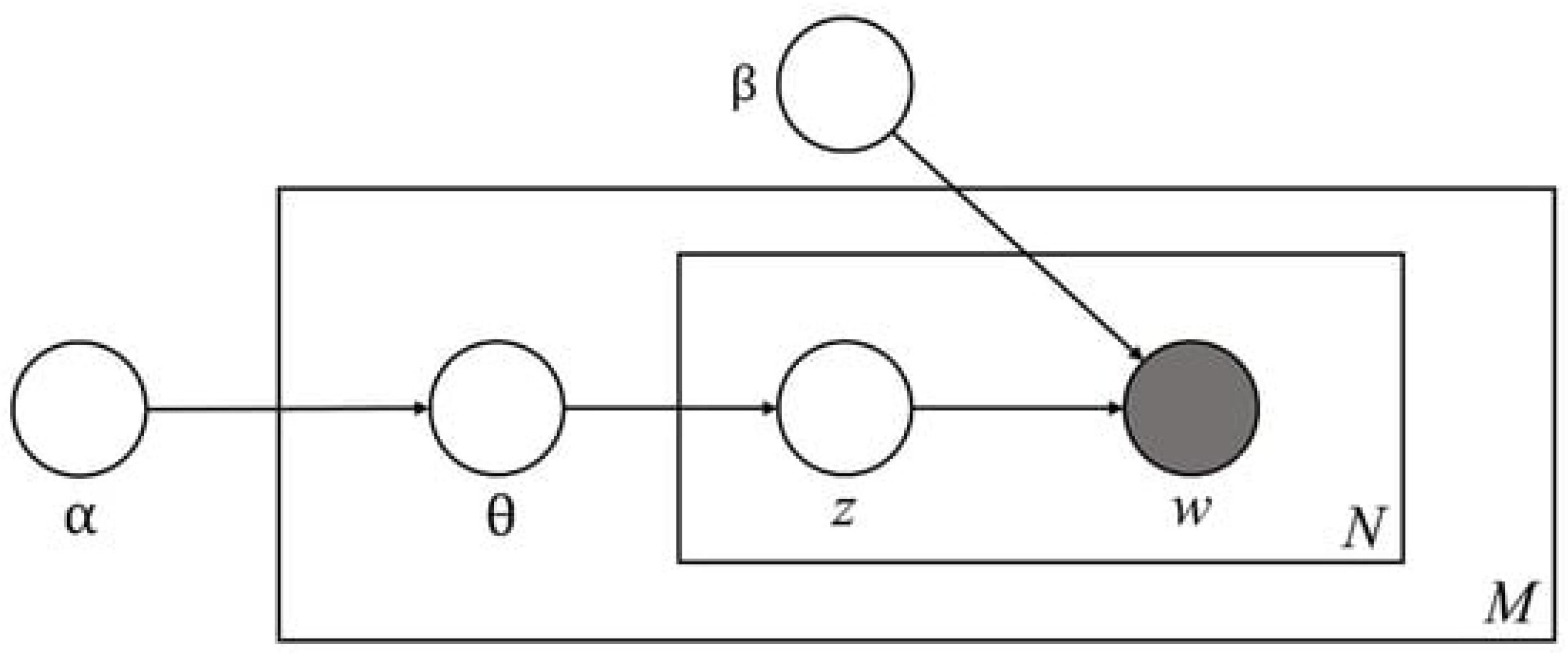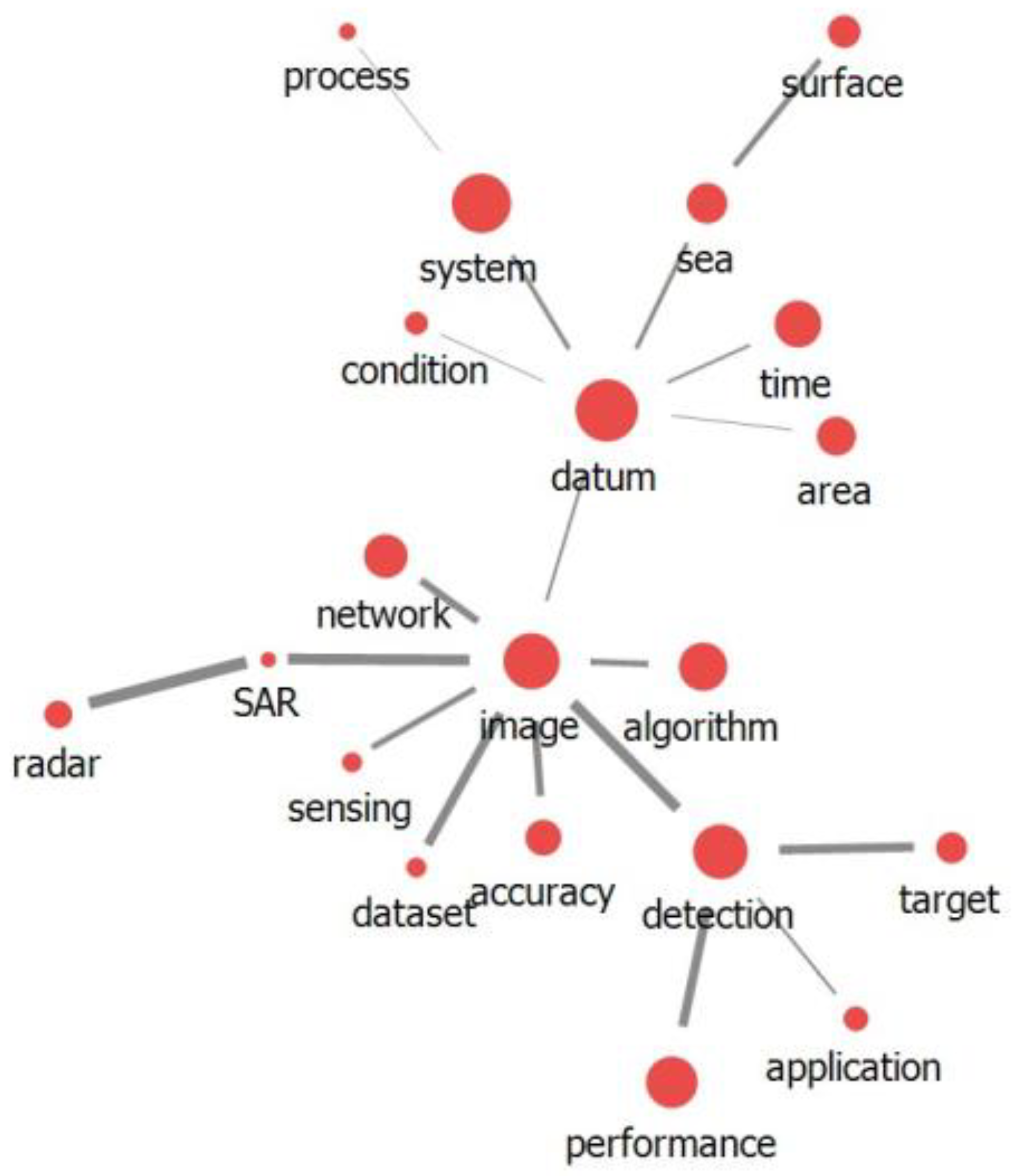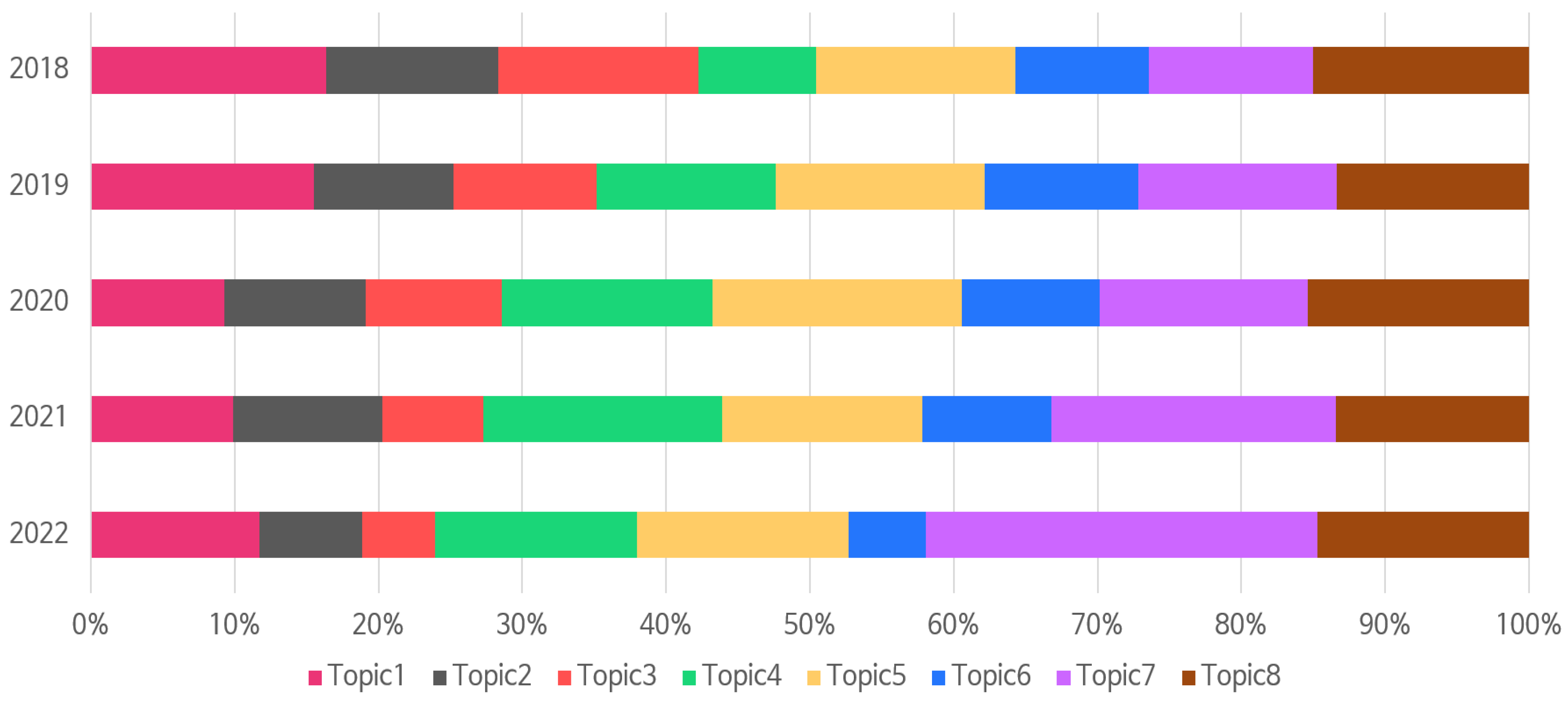Trend Research on Maritime Autonomous Surface Ships (MASSs) Based on Shipboard Electronics: Focusing on Text Mining and Network Analysis
Abstract
:1. Introduction
1.1. Background
1.2. Previous Research on Maritime Autonomous Surface Ships and Bibliometrics
1.3. Theoretical Background of Maritime Autonomous Surface Ships
1.3.1. Definition of Maritime Autonomous Surface Ships
1.3.2. Stages of Autonomy for Maritime Autonomous Surface Ships
1.4. The Need to Develop Maritime Autonomous Surface Ships
2. Materials and Methods
2.1. Research Subjects
2.1.1. Collecting Research Data
2.1.2. Refining Research Data
2.2. Research Methods
2.2.1. Co-Occurrence Analysis
2.2.2. LDA Topic Modeling
3. Results
3.1. Descriptive Statistics Analysis Results
3.1.1. Status by Country
3.1.2. Status by Institution
3.2. Results of Co-Occurrence Analysis
3.3. Results of LDA Topic Modeling
3.3.1. Coherence Score Measurement Results
3.3.2. Topic Classification Results
3.3.3. Topic Analysis by Year
4. Discussion
5. Conclusions
Author Contributions
Funding
Data Availability Statement
Acknowledgments
Conflicts of Interest
Abbreviations
| CNN | Convolutional Neural Network |
| IMO | International Maritime Organization |
| LDA | Latent Dirichlet Allocation |
| MASS | Maritime Autonomous Surface Ships |
| MSC | Maritime Safety Committee |
| PFnet | Path-Finer Network Scaling |
| SAR | Synthetic Aperture Radar |
| UN | United Nations |
References
- Aslam, S.; Michaelides, M.P.; Herodotou, H. Internet of Ships: A Survey on Architectures, Emerging Applications, and Challenges. IEEE Internet Things J. 2020, 7, 9714–9727. [Google Scholar] [CrossRef]
- Wróbel, K.; Gil, M.; Montewka, J. Identifying research directions of a remotely-controlled merchant ship by revisiting her system-theoretic safety control structure. Saf. Sci. 2020, 129, 104797. [Google Scholar] [CrossRef]
- Mauro, F.; Kana, A. Digital twin for ship life-cycle: A critical systematic review. Ocean Eng. 2023, 269, 113479. [Google Scholar] [CrossRef]
- Madusanka, N.S.; Fan, Y.; Yang, S.; Xiang, X. Digital Twin in the Maritime Domain: A Review and Emerging Trends. J. Mar. Sci. Eng. 2023, 11, 1021. [Google Scholar] [CrossRef]
- International Maritime Organization (IMO). Maritime Safety Committee (MSC). 2019. Available online: http://www.imo.org/en/MediaCentre/MeetingSummaries/MSC/Pages/Default.aspx (accessed on 11 November 2023).
- Liu, J.; Shi, G.; Zhu, K.; Shi, J. Research on MASS Collision Avoidance in Complex Waters Based on Deep Reinforcement Learning. J. Mar. Sci. Eng. 2023, 11, 779. [Google Scholar] [CrossRef]
- Ramos, M.A.; Utne, I.B.; Vinnem, J.E.; Mosleh, A. Accounting for Human Failure in Autonomous Ship Operations. In Safety and Reliability—Safe Societies in a Changing World; Haugen, S., Barros, A., van Gulijk, C., Kongsvik, T., Vinnem, J.E., Eds.; CRC Press: London, UK, 2018; pp. 1–10. [Google Scholar]
- Chang, Y.; Zhang, C.; Wang, N. The International Legal Status of Unmanned Maritime Vehicles. Mar. Policy 2020, 113, 103830. [Google Scholar] [CrossRef]
- Schmitt, M.N.; Goddard, D.S. International Law and the Military Use of Unmanned Maritime Systems. Int. Rev. Red Cross 2016, 98, 567–592. [Google Scholar] [CrossRef]
- Fan, C.; Wróbel, K.; Montewka, J.; Gil, M.; Wan, C.; Zhang, D. A Framework to Identify Factors Influencing Navigational Risk for Maritime Autonomous Surface Ships. Ocean Eng. 2020, 202, 107188. [Google Scholar] [CrossRef]
- Kim, D.; Lee, C.; Park, S.; Lim, S. Potential Liability Issues of AI-Based Embedded Software in Maritime Autonomous Surface Ships for Maritime Safety in the Korean Maritime Industry. J. Mar. Sci. Eng. 2022, 10, 498. [Google Scholar] [CrossRef]
- Utne, I.B.; Sorensen, A.J.; Schjolberg, I. Risk Management of Autonomous Marine Systems and Operations. In Proceedings of the International Conference on Offshore Mechanics and Arctic Engineering, Hamburg, Germany, 5–10 June 2017; pp. 1–10. [Google Scholar]
- Wrobel, K.; Montewka, J.; Kujala, P. Towards the Assessment of Potential Impact of Unmanned Vessels on Maritime Transportation Safety. Reliab. Eng. Syst. Saf. 2017, 165, 155–169. [Google Scholar] [CrossRef]
- Web of Science. Available online: https://www.webofscience.com (accessed on 22 November 2023).
- Ananiadou, S.; Rea, B.; Okazaki, N.; Procter, R.; Thomas, J. Supporting Systematic Reviews Using Text Mining. Soc. Sci. Comput. Rev. 2009, 27, 509–523. [Google Scholar] [CrossRef]
- Babić, D.; Kalić, M. Modeling the Selection of Airline Network Structure in a Competitive Environment. J. Air Transp. Manag. 2018, 66, 42–52. [Google Scholar] [CrossRef]
- Eroglu, Y. Text Mining Approach for Trend Tracking in Scientific Research: A Papers Study on Forest Fire. Fire 2023, 6, 33. [Google Scholar] [CrossRef]
- Rødseth, Ø.J.; Burmeister, H.C. Developments Toward the Unmanned Ship. In Proceedings of the International Symposium Information on Ships–ISIS 2012, Hamburg, Germany, 26 January 2012; Volume 201, pp. 30–31. [Google Scholar]
- Kim, T.-E.; Perera, L.P.; Sollid, M.-P.; Batalden, B.-M.; Sydnes, A.K. Safety Challenges Related to Autonomous Ships in Mixed Navigational Environments. WMU J. Marit. Aff. 2022, 21, 141–159. [Google Scholar] [CrossRef]
- Van Hooydonk, E. The law of unmanned merchant shipping—An exploration. J. Int. Marit. Law 2014, 20, 403–423. [Google Scholar]
- Ringbom, H.M.; Veal, R. Unmanned ships and the international regulatory framework. J. Int. Marit. Law 2017, 23, 100–118. [Google Scholar]
- Cui, K.; Lin, B.; Sun, W.; Sun, W. Learning-Based Task Offloading for Marine Fog-Cloud Computing Networks of USV Cluster. Electronics 2019, 8, 1287. [Google Scholar] [CrossRef]
- Santha Kumar, R.; Kaliyaperumal, K. A Scientometric Analysis of Mobile Technology Publications. Scientometrics 2015, 105, 921–939. [Google Scholar] [CrossRef]
- Zeng, Z.; Yang, D.; Huang, X.; Xiao, Z. Effect of Carbocisteine on Patients with COPD: A Systematic Review and Meta-Analysis. Int. J. Chronic Obstr. Pulm. Dis. 2017, 12, 2277–2283. [Google Scholar] [CrossRef] [PubMed]
- Hao, Y.; Ding, K.; Xu, Y.; Tang, Y.; Liu, D.; Li, G. States, Trends, and Future of Aquaponics Research. Sustainability 2020, 12, 7783. [Google Scholar] [CrossRef]
- Park, E.; Kim, W. What Are the Drivers of Citations? Application in Tourism and Hospitality Journals. Appl. Sci. 2021, 11, 9288. [Google Scholar] [CrossRef]
- International Maritime Organization (IMO). MSC 98th Agenda Item 20, Maritime Autonomous Surface Ships (Proposal for a Regulatory Scoping Exercise); International Maritime Organization (IMO): London, UK, 2017. [Google Scholar]
- Park, H.S.; Park, H.R. A Study on the Policy Directions related to the Introduction of Smart Maritime Autonomous Surface Ship (MASS); Korean Institute of Navigation and Port Research: Seoul, Republic of Korea, 2019. [Google Scholar]
- Arnsdorf, I. Roll-Royce Drone Ships Challenge $375 Billion Industry: Freight. Bloomberg Online. 2014. Available online: https://www.bloomberg.com/news/articles/2014-02-25/rolls-royce-drone-ships-challenge-375-billion-industry-freight (accessed on 23 November 2023).
- Lim, Y.; Lee, Y.C. Issues of Autonomous Ships and Implications for Maritime Legislation under IMO Agreements. Leg. Stud. 2018, 18, 155–181. [Google Scholar]
- Ortiz de Rozas, J.M. The Production of Unmanned Vessels and its Legal Implications in the Maritime Industry. Master’s Thesis, University of Oslo, Oslo, Norway, 2014. [Google Scholar]
- Pritchett, P.W. Ghost Ships: Why the Law Should Embrace Unmanned Vessel Technology. Tulane Marit. Law J. 2015, 40, 197. [Google Scholar]
- Choi, J.; Lee, S.I. An Analytical Review on the Seaworthiness of Unmanned Ships. Marit. Policy Res. 2018, 33, 171–191. [Google Scholar]
- Yoon, H.Y.; Kim, J.H.; Choi, H.C. Analysis of Research Trends on Secondary Batteries Using Bibliographic Information. J. Technol. Innov. 2023, 26, 463–478. [Google Scholar]
- Park, S.; Park, J. Identifying the Knowledge Structure and Trends of Outreach in Public Health Care: A Text Network Analysis and Topic Modeling. Int. J. Environ. Res. Public Health 2021, 18, 9309. [Google Scholar] [CrossRef] [PubMed]
- Jin, S.A.; Heo, G.E.; Jung, Y.K.; Song, M. A Study on Tracking Topic Changes Using Network Analysis Based on Twitter Data. J. Korean Soc. Inf. Manag. 2013, 30, 285–302. [Google Scholar]
- Kim, N.G.; Lee, D.H.; Choi, H.C. Trends in Text Analysis Technology and Its Applications. J. Korean Inst. Commun. Inf. Sci. 2017, 42, 471–492. [Google Scholar]
- Park, C.S.; Jeong, J.W. Text Network Analysis: A Papers of Understanding Shared Meanings Among Policy Stakeholders through Socio-Cognitive Network Analysis. In Proceedings of the Summer Annual Conference of the Korean Association for Policy Studies, Seoul, Republic of Korea, 31 May 2013; pp. 828–849. [Google Scholar]
- Schvaneveldt, R.W. Pathfinder Associative Networks: Studies in Knowledge Organization; Ablex Publishing: New York, NY, USA, 1990. [Google Scholar]
- Jelodar, H.; Wang, Y.; Yuan, C.; Feng, X. Latent Dirichlet Allocation (LDA) and Topic Modeling: Models, Applications, a Survey. Multimed. Tools Appl. 2019, 78, 15169–15211. [Google Scholar] [CrossRef]
- Tian, C.; Zhang, J.; Liu, D.; Wang, Q.; Lin, S. Technological Topic Analysis of Standard-Essential Patents Based on the Improved Latent Dirichlet Allocation (LDA) Model. Technol. Anal. Strat. Manag. 2022, 1–16. [Google Scholar] [CrossRef]
- Vorontsov, K.; Potapenko, A.; Plavin, A. Additive Regularization of Topic Models for Topic Selection and Sparse Factorization. In Proceedings of the Statistical Learning and Data Sciences: Third International Symposium, SLDS 2015, Egham, UK, 20–23 April 2015; pp. 193–202. [Google Scholar]
- O’Callaghan, D.; Greene, D.; Carthy, J.; Cunningham, P. An Analysis of the Coherence of Descriptors in Topic Modeling. Expert Syst. Appl. 2015, 42, 5645–5657. [Google Scholar] [CrossRef]
- Durbin, J.; Watson, G.S. Testing for Serial Correlation in Least Squares Regression. III. Biometrika 1971, 58, 1–9. [Google Scholar] [CrossRef]
- Seo, Y.; Kim, K.; Kim, J.-S. Trends of Nursing Research on Accidental Falls: A Topic Modeling Analysis. Int. J. Environ. Res. Public Health 2021, 18, 3963. [Google Scholar] [CrossRef] [PubMed]
- Röder, M.; Both, A.; Hinneburg, A. Exploring the Space of Topic Coherence Measures. In Proceedings of the Eighth ACM International Conference on Web Search and Data Mining, Shanghai, China, 2–6 February 2015; pp. 399–408. [Google Scholar]
- Im, J.-Y.; Yoon, J.-Y. Analysis of Trends in Domestic Workplace Women Research through Network Analysis. Asian Women 2018, 57, 201–236. [Google Scholar]
- Zhao, W.; Chen, J.; Zen, W. Best Practices in Building Topic Models with LDA for Mining Regulatory Textual Documents; CDER, 9 November 2015; FDA: Silver Spring, MD, USA, 2015. [Google Scholar]
- Lee, S.-J.; Chae, T.-B.; Kim, K.-T. Analysis of Ship Classification Performances Using Open-SARShip DB. Korean J. Remote Sens. 2018, 34, 801–810. [Google Scholar]
- Um, D.-Y.; Park, B.-S.; Lee, B.-H. Real-Time Observation-Based AI Prediction Technology Verification for Autonomous Navigation Ship Support. Proc. Korean Inst. Navig. Port Res. Acad. Conf. 2022, 2022, 172–173. [Google Scholar]
- Zhou, Y.; Gong, Y.; Geng, X.; Li, D.; Gao, B.; Li, C. An Algorithm for Path Planning of Autonomous Ships Considering the Influence of Wind and Wave. In Journal of Physics: Conference Series; IOP Publishing: Bristol, UK, 2021. [Google Scholar]
- Shin, J.-H. Legal Study on the Commercialization of Autonomous Transport Vehicles—Prospects and Legal Challenges of Autonomous Shipping Operations. Leg. Stud. 2020, 20, 43–70. [Google Scholar]
- Munim, Z.H.; Saha, R.; Schøyen, H.; Ng, A.K.; Notteboom, T.E. Autonomous Ships for Container Shipping in the Arctic Routes. J. Mar. Sci. Technol. 2022, 27, 320–334. [Google Scholar] [CrossRef]
- Zhang, X.; Wang, C.; Jiang, L.; An, L.; Yang, R. Collision-Avoidance Navigation Systems for Maritime Autonomous Surface Ships: A State of the Art Survey. Ocean. Eng. 2021, 235, 109380. [Google Scholar] [CrossRef]
- Konstantinos, N.S.; Elissavet, R.N.; Panagiotis, M.G.; Ioannis, B.A.; Konstantinos, B.D. Performance Indicators and Competition Ranking in Women’s and Men’s World Handball Championship 2017. J. Phys. Educ. Sport 2018, 18, 1761–1766. [Google Scholar]
- Choi, H.M.; Kim, M.K.; Yang, H. Deep-Learning Model for Sea Surface Temperature Prediction Near the Korean Peninsula. Deep. Sea Res. Part II Top. Stud. Oceanogr. 2023, 208, 105262. [Google Scholar] [CrossRef]
- Nam, K.-W.; Noh, M.-I.; Lee, H.-W.; Lee, W.-J. Deep Learning-Based Ship Image Classification Method for Autonomous Navigation Ships. J. Korean Soc. Comput. Eng. Inf. Technol. 2021, 26, 144–153. [Google Scholar]
- Escorcia-Gutierrez, J.; Gamarra, M.; Beleño, K.; Soto, C.; Mansour, R.F. Intelligent Deep Learning-Enabled Autonomous Small Ship Detection and Classification Model. Comput. Electr. Eng. 2022, 100, 107871. [Google Scholar] [CrossRef]
- Tsvetkova, A.; Hellström, M. Creating Value through Autonomous Shipping: An Ecosystem Perspective. Marit. Econ. Logist. 2022, 24, 255–277. [Google Scholar] [CrossRef]
- Yoo, J. The Effectuation of the IMO’s Polar Code and Its Remaining Issues to Tackle in the Age of Global Warming; Policy reports; Korea Institute of Legal Studies: New York, NY, USA, 2019. [Google Scholar]






| Term | Description |
|---|---|
| Maritime Autonomous Surface Ship | Operates autonomously, with or without crew. |
| Smart Ship | Enhances safety and efficiency through connectivity and automation. |
| Digital Ship | Operates using digital and IT-based systems. |
| Unmanned Ship | Controlled remotely without an onboard crew. |
| Autonomous Ship | Functions based on remote or automated commands. |
| Remote Ship | Directly controlled by an onshore operator. |
| Level | Description |
|---|---|
| 1 | Ship with automated processes and decision support. Seafarers are present on board to operate and control the shipboard systems and functions. Some operations may be automated. |
| 2 | Remotely controlled ship without seafarers on board. The ship is controlled and operated from another location. |
| 3 | Remotely controlled ship without seafarers on board. The ship is controlled and operated from another location. |
| 4 | Fully autonomous ship. The operating system of the ship can make decisions and determine actions by itself. |
| Status | 2018 | 2019 | 2020 | 2021 | 2022 | 2018~2022 |
|---|---|---|---|---|---|---|
| 1 | CHINA (120 papers) | CHINA (204 papers) | CHINA (246 papers) | CHINA (381 papers) | CHINA (560 papers) | CHINA (1511 papers) |
| 2 | USA (85 papers) | USA (104 papers) | USA (90 papers) | USA (91 papers) | USA (95 papers) | USA (465 papers) |
| 3 | S. KOREA (29 papers) | GERMANY (45 papers) | S. KOREA (56 papers) | S. KOREA (67 papers) | S. KOREA (76 papers) | S. KOREA (255 papers) |
| 4 | GERMANY (25 papers) | CANADA (32 papers) | ENGLAND (34 papers) | ENGLAND (43 papers) | NORWAY (50 papers) | GERMANY (185 papers) |
| 5 | CANADA (24 papers) | ITALY (28 papers) | ITALY (32 papers) | GERMANY (41 papers) | GERMANY (47 papers) | CANADA (162 papers) |
| Status | 2018 | 2019 | 2020 | 2021 | 2022 | Cumulative Number of Papers |
|---|---|---|---|---|---|---|
| 1 | CHINESE ACADEMY OF SCIENCES (19 papers) | CHINESE ACADEMY OF SCIENCES (33 papers) | CHINESE ACADEMY OF SCIENCES (38 papers) | CHINESE ACADEMY OF SCIENCES (50 papers) | CHINESE ACADEMY OF SCIENCES (65 papers) | CHINESE ACADEMY OF SCIENCES (205 papers) |
| 2 | UNIVERSITY OF CHINESE ACADEMY OF SCIENCES (14 papers) | UNIVERSITY OF CALIFORNIA SYSTEM (25 papers) | WUHAN UNIVERSITY (30 papers) | DALIAN MARITIME UNIVERSITY (46 papers) | DALIAN MARITIME UNIVERSITY (47 papers) | DALIAN MARITIME UNIVERSITY (132 papers) |
| 3 | HELMHOLTZ ASSOCIATION (13 papers) | HELMHOLTZ ASSOCIATION (24 papers) | DALIAN MARITIME UNIVERSITY (21 papers) | WUHAN UNIVERSITY (29 papers) | UNIVERSITY OF CHINESE ACADEMY OF SCIENCES (40 papers) | UNIVERSITY OF CHINESE ACADEMY OF SCIENCES (115 papers) |
| 4 | CENTRE NATIONAL DE LA RECHERCHE SCIENTIFIQUE (11 papers) | UNIVERSITY OF CHINESE ACADEMY OF SCIENCES (16 papers) | UNIVERSITY OF CHINESE ACADEMY OF SCIENCES (20 papers) | XIDAN UNIVERSITY (26 papers) | WUHAN UNIVERSITY (38 papers) | WUHAN UNIVERSITY (111 papers) |
| 5 | NATIONAL UNIVERSITY OF DEFENSE TECHNOLOGY CHINA (11 papers) | WUHAN UNIVERSITY (16 papers) | SEOUL NATIONAL UNIVERSITY (13 papers) | UNIVERSITY OF CHINESE ACADEMY OF SCIENCES (25 papers) | XIDAN UNIVERSITY (33 papers) | XIDAN UNIVERSITY (86 papers) |
| Status | Main Keywords (Frequency of Occurrence) | Status | Main Keywords (Frequency of Occurrence) |
|---|---|---|---|
| 1 | detection (3428) | 11 | time (1178) |
| 2 | datum (2991) | 12 | water (1166) |
| 3 | image (2876) | 13 | area (1101) |
| 4 | system (2590) | 14 | surface (1096) |
| 5 | SAR (1901) | 15 | control (991) |
| 6 | target (1708) | 16 | accuracy (976) |
| 7 | network (1653) | 17 | radar (950) |
| 8 | algorithm (1625) | 18 | dataset (944) |
| 9 | sea (1430) | 19 | object (929) |
| 10 | performance (1383) | 20 | sensing (882) |
| Topic 1 (11.98%) | Topic 2 (9.28%) | Topic 3 (7.94%) | Topic 4 (13.83%) | ||||||||
| Rank | Keyword | Prob | Rank | Keyword | Prob | Rank | Keyword | Prob | Rank | Keyword | Prob |
| 1 | detection | 0.035 | 1 | datum | 0.037 | 1 | ice | 0.031 | 1 | system | 0.033 |
| 2 | target | 0.034 | 2 | measurement | 0.019 | 2 | concentration | 0.02 | 2 | control | 0.026 |
| 3 | image | 0.03 | 3 | satellite | 0.018 | 3 | water | 0.015 | 3 | navigation | 0.015 |
| 4 | SAR | 0.028 | 4 | wave | 0.017 | 4 | sea | 0.014 | 4 | algorithm | 0.015 |
| 5 | radar | 0.027 | 5 | surface | 0.016 | 5 | Arctic | 0.012 | 5 | collision | 0.013 |
| 6 | sea | 0.02 | 6 | water | 0.016 | 6 | region | 0.011 | 6 | datum | 0.012 |
| 7 | datum | 0.018 | 7 | ocean | 0.015 | 7 | emission | 0.01 | 7 | motion | 0.008 |
| 8 | algorithm | 0.015 | 8 | wind | 0.014 | 8 | cloud | 0.009 | 8 | simulation | 0.008 |
| 9 | wake | 0.011 | 9 | observation | 0.012 | 9 | surface | 0.009 | 9 | surface | 0.008 |
| 10 | clutter | 0.011 | 10 | sensing | 0.011 | 10 | particle | 0.009 | 10 | path | 0.008 |
| Situational awareness technology research | Ocean observation and sensing research | Arctic navigation research | Navigation decision-making and control technology research | ||||||||
| Topic 5 (14.87%) | Topic 6 (8.15%) | Topic 7 (19.60%) | Topic 8 (14.36%) | ||||||||
| Rank | Keyword | Prob | Rank | Keyword | Prob | Rank | Keyword | Prob | Rank | Keyword | Prob |
| 1 | system | 0.022 | 1 | area | 0.021 | 1 | detection | 0.059 | 1 | system | 0.014 |
| 2 | energy | 0.017 | 2 | oil | 0.018 | 2 | image | 0.049 | 2 | technology | 0.012 |
| 3 | design | 0.013 | 3 | datum | 0.013 | 3 | network | 0.031 | 3 | shipping | 0.011 |
| 4 | power | 0.013 | 4 | water | 0.012 | 4 | SAR | 0.028 | 4 | datum | 0.01 |
| 5 | structure | 0.01 | 5 | marine | 0.01 | 5 | object | 0.02 | 5 | service | 0.008 |
| 6 | condition | 0.009 | 6 | activity | 0.009 | 6 | dataset | 0.02 | 6 | port | 0.007 |
| 7 | performance | 0.008 | 7 | monitoring | 0.008 | 7 | target | 0.018 | 7 | development | 0.007 |
| 8 | process | 0.008 | 8 | fishing | 0.007 | 8 | performance | 0.015 | 8 | industry | 0.007 |
| 9 | fuel | 0.008 | 9 | spill | 0.007 | 9 | classification | 0.015 | 9 | management | 0.007 |
| 10 | load | 0.008 | 10 | island | 0.007 | 10 | accuracy | 0.014 | 10 | time | 0.006 |
| Research on energy and high-efficiency navigation technology | Research on the derivation of autonomous ships | Research on image analysis and classification | Research on port connectivity | ||||||||
Disclaimer/Publisher’s Note: The statements, opinions and data contained in all publications are solely those of the individual author(s) and contributor(s) and not of MDPI and/or the editor(s). MDPI and/or the editor(s) disclaim responsibility for any injury to people or property resulting from any ideas, methods, instructions or products referred to in the content. |
© 2024 by the authors. Licensee MDPI, Basel, Switzerland. This article is an open access article distributed under the terms and conditions of the Creative Commons Attribution (CC BY) license (https://creativecommons.org/licenses/by/4.0/).
Share and Cite
Kim, J.; Han, S.; Lee, H.; Koo, B.; Nam, M.; Jang, K.; Lee, J.; Chung, M. Trend Research on Maritime Autonomous Surface Ships (MASSs) Based on Shipboard Electronics: Focusing on Text Mining and Network Analysis. Electronics 2024, 13, 1902. https://doi.org/10.3390/electronics13101902
Kim J, Han S, Lee H, Koo B, Nam M, Jang K, Lee J, Chung M. Trend Research on Maritime Autonomous Surface Ships (MASSs) Based on Shipboard Electronics: Focusing on Text Mining and Network Analysis. Electronics. 2024; 13(10):1902. https://doi.org/10.3390/electronics13101902
Chicago/Turabian StyleKim, Jinsick, Sungwon Han, Hyeyoung Lee, Byeongsoo Koo, Moonju Nam, Kukjin Jang, Jooyeoun Lee, and Myoungsug Chung. 2024. "Trend Research on Maritime Autonomous Surface Ships (MASSs) Based on Shipboard Electronics: Focusing on Text Mining and Network Analysis" Electronics 13, no. 10: 1902. https://doi.org/10.3390/electronics13101902
APA StyleKim, J., Han, S., Lee, H., Koo, B., Nam, M., Jang, K., Lee, J., & Chung, M. (2024). Trend Research on Maritime Autonomous Surface Ships (MASSs) Based on Shipboard Electronics: Focusing on Text Mining and Network Analysis. Electronics, 13(10), 1902. https://doi.org/10.3390/electronics13101902






